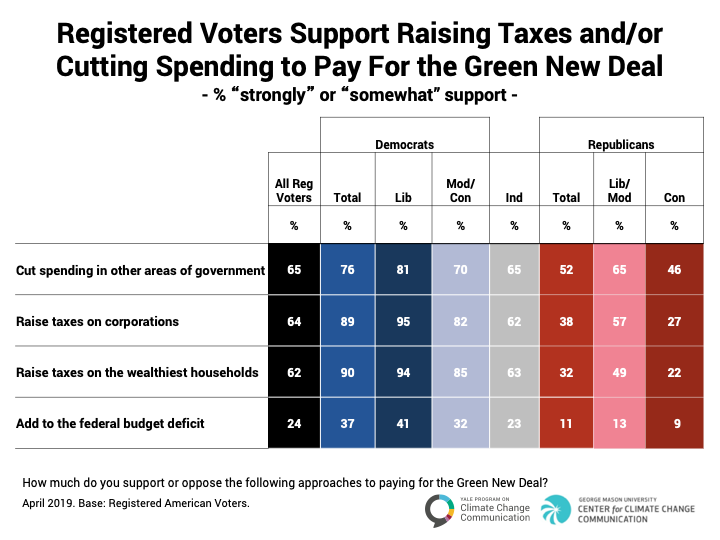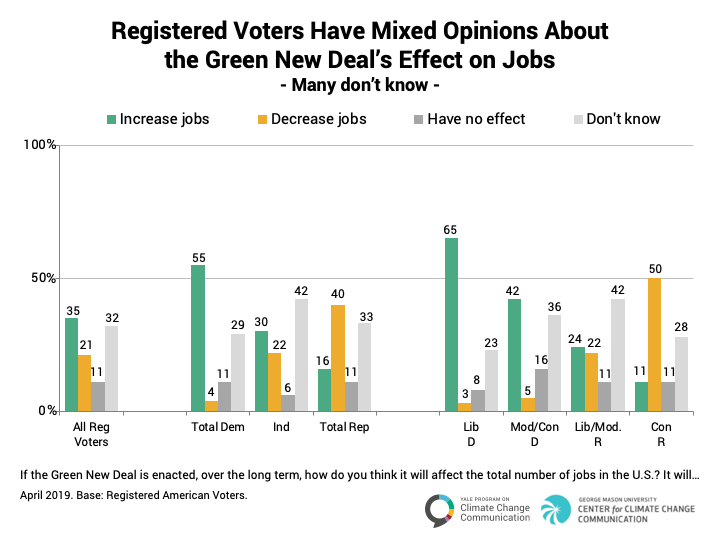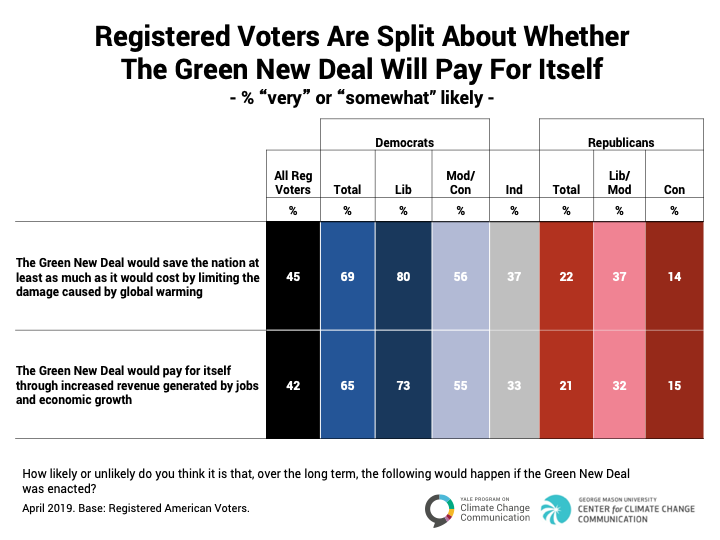Report · May 16, 2019
Politics & Global Warming, April 2019
By Anthony Leiserowitz, Edward Maibach, Seth Rosenthal, John Kotcher, Matthew Ballew, Matthew Goldberg, Abel Gustafson and Parrish Bergquist
Filed under: Policy & Politics, Beliefs & Attitudes and Behaviors & Actions
4. Special Policy Section: The Green New Deal
4.1. A majority of registered voters support a “Green New Deal.”
As we reported earlier in May, a majority of registered voters support the policy aspirations included in a proposal called the Green New Deal, although support has decreased since December, particularly among conservative Republicans and regular viewers of the Fox News Channel. The description of the policy was summarized based on a 2018 policy report: https://www.dataforprogress.org/green-new-deal/#introduction “the Green New Deal will produce jobs and strengthen America’s economy by accelerating the transition from fossil fuels to clean, renewable energy. The Deal would generate 100% of the nation’s electricity from clean, renewable sources within the next 10 years; upgrade the nation’s energy grid, buildings, and transportation infrastructure; increase energy efficiency; invest in green technology research and development; and provide training for jobs in the new green economy.”
About seven in ten (69%) registered voters support the Green New Deal as described above, including large majorities of Democrats (93%) and a majority of Independents (64%). Fewer Republicans (44%), including a majority of liberal/moderate Republicans (64%) but only about one in three conservative Republicans (32%) also support the Green New Deal.
4.2. Registered voters support raising taxes and/or cutting spending to pay for the Green New Deal
Six in ten or more registered voters support cutting spending in other areas of government (65%), raising taxes on corporations (64%), and/or raising taxes on the wealthiest households (62%) to pay for the Green New Deal.
Democrats most strongly support paying for the Green New Deal by raising taxes (on wealthy households, 90%; on corporations, 89%). Republicans most strongly support paying by cutting spending in other areas of government (52%, including 65% of liberal/moderate Republicans and 46% of conservative Republicans).
Relatively few registered voters (24%) support paying for the Green New Deal by adding to the federal budget deficit – majorities of each political group “strongly” or “somewhat” oppose adding to the deficit to pay for the Green New Deal (see Data Tables).
4.3. Registered voters have mixed opinions about the Green New Deal’s effect on jobs; many don’t know.
By a margin of 14 percentage points, registered voters in the U.S. think the Green New Deal is more likely to increase the total number of jobs in the U.S. (35%) than decrease the total number of jobs (21%). Few (11%) think it will have no effect, but many (32%) don’t know.
More than half of Democrats think the Green New Deal will increase jobs in the U.S. (55%; 65% of liberal Democrats), while four in ten Republicans think it will decrease jobs (40%; 50% of conservative Republicans). Independents are split – more Independents don’t know (42%) than think it will increase (30%) or decrease (22%) jobs.
4.4. Registered voters have mixed opinions about the Green New Deal’s effect on the U.S. economy; many don’t know.
By a margin of ten percentage points, registered voters in the U.S. think the Green New Deal is more likely to help the economy (36%) than hurt the economy (26%). Few (7%) think it will have no effect, but many (29%) don’t know.
More than half of Democrats think the Green New Deal will help the economy (56%; 65% of liberal Democrats), while almost half of Republicans think it will hurt the economy (48%; 58% of conservative Republicans). Independents are about equally split – 33% of Independents don’t know (an additional 2% did not provide a response), 32% think it will help the economy, and 28% think it will hurt the economy.
4.5. Registered voters are split about whether the Green New Deal will pay for itself.
Four in ten or more registered voters think the Green New Deal will pay for itself, either saving the nation at least as much as it would cost by limiting the damage caused by global warming (45% think this is “very” or “somewhat” likely) and/or through increased revenue generated by jobs and economic growth (42%). Fewer think these scenarios are “very” or “somewhat” unlikely (33% and 37% respectively; see Data Tables). For both scenarios, an additional one in five registered voters (21%) say they “don’t know.”
About two in three Democrats think both scenarios are at least somewhat likely (69% and 65% respectively), including large majorities of liberal Democrats (80% and 73%). Only about one in five Republicans think either scenario is likely (22% and 21%).
4.6. A plurality of registered voters think Congress should focus on global warming and other issues together in a broad policy program.
More than four in ten registered voters (45%) think the best way for the U.S. to solve global warming is to make global warming policies part of a broader program that also addresses other issues. This is nearly three times the number who think government policies should focus on global warming alone (16%). One in five (20%) say the government should do neither, and an additional 19% don’t know (1% did not provide a response).
A majority of Democrats (58%; 66% of liberal Democrats) think the government’s global warming policies should be part of a broader policy program, as do more than one in three Independents (37%) and Republicans (34%). Nearly half of conservative Republicans (48%) prefer that the government take neither approach.





